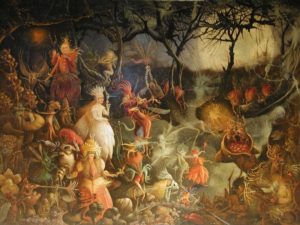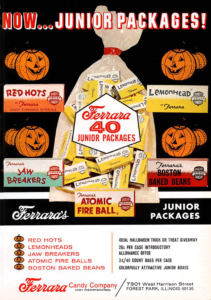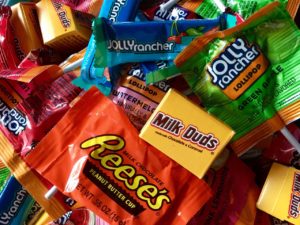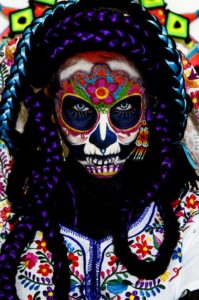
According to History.com, Halloween, an American holiday celebrated every year on October 31, originated in the ancient Celtic festival of Samhain (pronounced sow-in). Over 2,000 years ago the Celts occupied what is now Ireland, the United Kingdom and parts of France and Spain. November 1 was the beginning of the Celtic New Year. They believed that on the night before the New Year, the ghosts of the dead returned to earth. The Celtic priests, or Druids, built huge sacred bonfires that people used to burn crops and livestock as sacrifices to the Celtic deities.
From Pagan Festival to Popular Party Night

By the 9th century Christianity’s influence spread into Celtic lands. In 1000 A.D., the Church declared November 1 All Souls’ Day to honor the dead as part of its program to replace pagan festivals with church-sanctioned holidays. It was celebrated much like Samhain, with bonfires, parades and wearing costumes portraying saints, angels and devils. The celebration was also called All-hallows or All-hallowmas, from Middle English Alholomesse, meaning All Saints’ Day. The night before, the traditional Samhain of the Celtic religion, came to be called A-Hallows Eve, and eventually, Halloween.
“Trick or Treat” — Who Said it First?

Before the middle of the nineteenth century, Halloween was celebrated only in a few places in America. But a wave of new immigrants in the final half of the century helped popularize the holiday. Influenced by English and Irish traditions, Americans began to dress in costumes and go from door to door asking for food or money. Most of the food given out was prepared in the home, such as pastries called “soul cakes.”
This practice would eventually came to be called “trick-or-treat” but the term wasn’t used until the 1920s. The earliest known reference appeared in the November 4, 1927 edition of the Blackie, Alberta Canada Times. By then the practice of giving food changed from home cooked to candy purchased from retailers.
Many varieties of early candy would sound familiar to us today: Candy Corn first appeared in the 1880s, Tootsie Rolls & Juicy Fruit gum in the 1890s, Hershey bars & Hershey kisses by 1900s, Candy Apples in 1908, Reese’s Cups in the 1920s and M&Ms in the 1940s.
Many candies kids enjoyed from the 1900s through the 1940s have disappeared except for suppliers that sell retro candies. They include Boston Baked Beans, Red Hots Cinnamon, Jelly Bellies, Chick O Sticks, Candy Buttons, Valomilk Candy Cups and more. However, just as superheroes Superman and Batman made their appearance in the ’30s, a few names still familiar to us emerged: Snickers, 3 Musketeers and Kit Kat. A few familiar favorites, such as Baby Ruth, Milky Way and Mounds candy bars, had been around since the 1900s.
We Eat HOW Much Candy for Halloween?

Halloween is a favorite American holiday. The National Retail Federation projected total expenditures for Halloween for 2017 at $9.1 billion. $2.7 billion of that was for candy. According to Visually, Americans purchase nearly 600 million tons of candy each year for Halloween. An incredible 90 million pounds of this is chocolate, the favorite candy source for Halloween.
This alarming quantity of candy, most of it in the hands of children, prompted the Halloween Candy Buy Back (HCBB) program in 2005. Buy backs are held at dental offices and local businesses. Participants buy back kids’ candy with cash, coupons or tooth brushes and send the candy to troops overseas. The program was started by Dr. Curtis Kammer, a dentist in Wisconsin. The program went nationwide in 2007.
Speaking of chocolate, American and European varieties differ. GourmetBoutique.net provides four differing characteristics. One is the amount of cacao. The United States requires 10% cacao while the requirement in European countries is 20% cacao. For example, an American Hershey bar contains only 11% cacao while a Cadbury Dairy Milk bar has 23%. American bars contain more sugar to make up for a lack of cacao. And European chocolates use more cacao butter and European butter and cream which adds more fat content, leading to a smoother, richer flavor.
The Candy Industry website lists the 100 largest candy companies in the world each year. The largest company in 2018 is Mars, Inc., based in Chicago, IL, USA. The second is Ferrero Group of Luxembourg and Italy and the third is Mondelez International of Deerfield, IL, USA. Fourth, fifth and sixth in descending order are the Meiji Co. Ltd. Of Tokyo, Japan; Nestle SA of Vevey, Switzerland and Hershey Co. of Hershey, PA, USA.
Halloween Traditions Around the Globe
Mental Floss lists Halloween and Halloween-like traditions celebrated around the world.

- Samhain is still celebrated in its birthplace, Ireland and Scotland, with bonfires, games and traditional foods like barmbrack, an Irish fruitcake.
- Dia de los Muertos (Day of the Dead), honoring those who have passed away, is celebrated in Mexico and parts of Latin America on November 1 and 2.
- People from all over the world visit Vlad “The Impaler” Tepe’s supposed castle in Transylvania, Romania on Halloween, though it was never actually his castle.
- On Halloween, partiers from around the world converge on Japan to participate in the Kawasaki Halloween Parade.
- In the Philippines, children go door to door on Pangangaluluwa, often in costumes, singing and asking for prayers for those in purgatory.
- Dzien Zaduszny is the equivalent of All Souls Day for Catholics in Poland. They celebrate it with candles, flowers and prayers for departed relatives.
- On November 1, Italians celebrate All Saints’ Day, or Ognissanti, by placing flowers on the graves of the departed and setting a place for them at the dining table.
- In Cambodia, from the end of September to mid-October, Buddhist families celebrate Pchum Ben to honor the dead. They decorate temples with flowers and give away food.
“Halloween parties involving age-old activities such as bobbing for apples and giving gifts becomes more popular every year.”
In the United States, as in most other countries, the gathering of friends and family for the Halloween celebration is important. Halloween parties involving age-old activities such as bobbing for apples and giving gifts becomes more popular every year.
For more fun Halloween ideas from Elfster, check out our Halloween Gift Guides. You can share your favorite costume, present, and party ideas with us on our Facebook page, on Twitter @Elfster, and on Instagram @Elfster.

